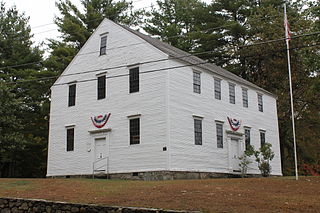
The Danville Meetinghouse is a historic colonial meeting house on North Main Street in Danville, New Hampshire. Construction on the building began in 1755 and was finished in 1760 when Danville petitioned to form a town of its own, separate from Kingston. It is the oldest meetinghouse of original construction and least-altered in New Hampshire, with a remarkably well preserved interior. The building, now maintained by a local nonprofit organization, was added to the National Register of Historic Places in 1982.

White's Tavern is a historic former tavern on United States Route 6 in Andover, Connecticut. Built in 1773, it is a well-preserved example of colonial architecture, notable for hosting French Army officers in the American Revolutionary War. Now a private residence, the building was listed on the National Register of Historic Places in 1991.

The Black Horse Tavern is an historic tavern on Searsport Avenue in Belfast, Maine. Built in 1795, it was the city's first tavern located on the eastern side of the Passagassawakeag River, and is a well-preserved example of vernacular Federal period architecture. The building, now a private residence, was added to the National Register of Historic Places in 1982.

The Moses Kent House is a historic house on River Road in Lyme, New Hampshire. Built in 1811, it is a good local example of Federal period architecture, most notable for the well-preserved murals on its interior walls, drawn by the itinerant artist Rufus Porter. The house was listed on the National Register of Historic Places in 1984.

The Howe-Quimby House is a historic house on Sugar Hill Road in Hopkinton, New Hampshire. Built about 1780, it is a well-preserved example of a rural 18th-century farmhouse with later stylistic modifications. The house was listed on the National Register of Historic Places in 1980.

The Clymer House is a historic house at 31 Clymer Road in Harrisville, New Hampshire. Built in 1932, it is a finely crafted example of Colonial Revival architecture, built in conscious imitation of an earlier form that might have occupied the same site. The house was listed on the National Register of Historic Places in 1988.

The Jeremiah Hutchins Tavern is a historic former tavern on United States Route 302 in northwestern Bath, New Hampshire. Built by 1799 by one of the town's early settlers, the building is one of the town's finest surviving examples of transitional Georgian-Federal architecture. The building was listed on the National Register of Historic Places in 1984.

The Whipple House is a historic house museum at 4 Pleasant Street in Ashland, New Hampshire. Built about 1837, it is a well-preserved example of a mid-19th century Cape-style house, that is relatively architecturally undistinguished. It is significant for its association with George Hoyt Whipple (1878–1976), a Nobel Prize-winning doctor and pathologist who was born here. Whipple gave the house to the town in 1970, and it is now operated by the Ashland Historical Society as a museum, open during the warmer months. The house was listed on the National Register of Historic Places in 1978.

The Sawyer–Medlicott House is a historic house at the junction of Bradford and River roads in Piermont, New Hampshire. Built about 1820, it is a good example of Federal period architecture, and the only brick house of that style in the small town. It was built for Joseph Sawyer, a real estate speculator and politician. The house was listed on the National Register of Historic Places in 1991.
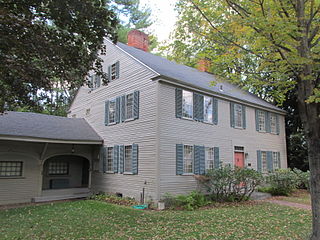
The Sawyer Tavern is a historic building at 63 Arch Street in Keene, New Hampshire. Probably built c. 1803–06, it was long a neighborhood landmark, serving as a tavern and then inn and restaurant for parts of the 19th and 20th centuries. The building is now in residential use. It was listed on the National Register of Historic Places in 1980, and the New Hampshire State Register of Historic Places in 2007.

The McClure-Hilton House is a historic house at 16 Tinker Road in Merrimack, New Hampshire. The oldest portion of this 1+1⁄2-story Cape style house was built c. 1741, and is one of the oldest surviving houses in the area. It was owned by the same family for over 200 years, and its interior includes stencilwork that may have been made by Moses Eaton Jr., an itinerant artist of the 19th century. The property also includes a barn, located on the other side of Tinker Road, which is of great antiquity. The property was listed on the National Register of Historic Places in 1989.

The William Peabody House is a historic house on North River Road in Milford, New Hampshire. This 2+1⁄2-story wood-frame house was built c. 1740 by William Peabody, the first English settler of the Milford area, and remains a good example of Georgian residential architecture despite a 1973 fire. The house was listed on the National Register of Historic Places in 1979.

The Temple Town Hall, also known as the Union Hall and the Miller Grange Hall, is a historic municipal building in the center of Temple, New Hampshire. Built in 1842, it is a fine example of Greek Revival architecture, which has served the community as a church, Grange hall, and town hall. It continues to be used for social functions. The building was listed on the National Register of Historic Places in June 2007, and the New Hampshire State Register of Historic Places in April 2007.
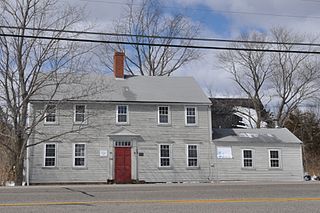
The John Crockett House, also known as Kenniston's Tavern, is a historic house at 245 Portsmouth Road in Stratham, New Hampshire in the United States. Built about 1760, it is a well-preserved example of Georgian residential architecture. It was operated for a time as a tavern serving travelers on the main road between Portsmouth and Exeter. The house was listed on the National Register of Historic Places in 1983.

The Dudley House, also known as the Perry-Dudley House, is a historic house at 14 Front Street in Exeter, New Hampshire. Built about 1805, it is a prominent local example of Federal architecture, further notable for its occupation by two of the town's leading 19th-century doctors. The house was listed on the National Register of Historic Places in 1971. It now houses professional offices.

The Protectworth Tavern, also known as the Stickney Tavern, is a historic house on New Hampshire Route 4A in Springfield, New Hampshire. It is a nearly-intact example of a late-Georgian early-Federal vernacular house, dating to the time of the construction of the "Fourth New Hampshire Turnpike", a major early highway through this region of central New Hampshire whose route is followed here by Route 4A. The house was long used as a tavern, and one of its early owners was Daniel Noyes, a proprietor of the Turnpike. Meetings of the Turnpike's owners are known to have taken place here. A later owner, Nathaniel Stickney, was also a stagecoach driver on the route. The house was listed on the National Register of Historic Places in 1980.
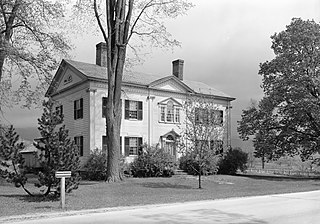
The Munro-Hawkins House is a historic house on Vermont Route 7A in southern Shaftsbury, Vermont. Built in 1807, it is a well-preserved example of transitional Georgian-Federal period architecture, designed by local master builder Lavius Fillmore. It was listed on the National Register of Historic Places in 1973.
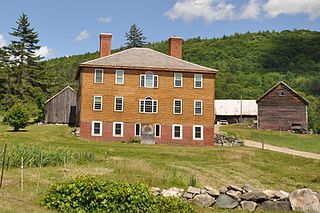
The Jeffrey House is a historic house on North Street in Chester, Vermont. Built in 1797, it is one of Vermont's small number of surviving Georgian style houses. It was built by the son of one of the area's early settlers, and originally served as a tavern. It was listed on the National Register of Historic Places in 1974.

The Elkins Tavern is a historic house on Bayley-Hazen Road in Peacham, Vermont. Built in 1787 by one of Peacham's first settlers, it has one of the best-preserved 18th-century interiors in the state of Vermont. It was listed on the National Register of Historic Places in 1978.

The John Robbins House is a historic house at 262 Old Main Street in Rocky Hill, Connecticut. Normally attributed a construction date of 1767, it is considered one of the finest examples of brick Georgian architecture in the state. It was listed on the National Register of Historic Places in 1988.























